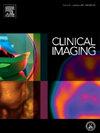The diagnostic performance of dual-energy CT in detecting chronic thromboembolic pulmonary hypertension: A systematic-review and Meta-analysis
IF 1.5
4区 医学
Q3 RADIOLOGY, NUCLEAR MEDICINE & MEDICAL IMAGING
引用次数: 0
Abstract
Background and aims
Chronic thromboembolic pulmonary hypertension (CTEPH) is a severe, treatable condition often underdiagnosed due to nonspecific symptoms. Dual-Energy Computed Tomography (DECT) shows promise in the detailed assessment of pulmonary perfusion, providing quantitative values such as perfused blood volume (PBV) and iodine density (ID), potentially helpful in detecting CTEPH. This meta-analysis evaluates the diagnostic accuracy of DECT in detecting CTEPH and its potential role in clinical management.
Methods
Following PRISMA guidelines, a literature search was conducted in PubMed, Web of Science, Scopus, and Embase up to June 2024. Studies providing diagnostic accuracy data for DECT in CTEPH were included. Data were aggregated using a bivariate model in the R statistical programming environment.
Results
Nine studies with 751 participants were included. The pooled sensitivity and specificity of DECT for detecting CTEPH were 87.5 % (95 % CI: 74.8–94.2 %) and 91.2 % (95 % CI: 84.1–95.3 %), with an AUC of 0.95 (95 % CI: 0.87–0.97). The diagnostic accuracy did not significantly differ when distinguishing CTEPH from acute pulmonary thromboembolism (APTE) or non-thromboembolic conditions (p = 0.781). Subgroup analyses based on different quantitative indices and patient vs. segment-based assessments showed no significant differences. Heterogeneity was high, and the risk of bias assessment identified concerns regarding patient selection.
Conclusion
DECT shows promising diagnostic accuracy in detecting CTEPH. However, its suboptimal sensitivity and variability in protocols pose challenges. Future research should focus on identifying optimal diagnostic criteria, indices, and thresholds to standardize DECT use in clinical practice for broader applicability.
双能CT检测慢性血栓栓塞性肺动脉高压的诊断性能:系统回顾和meta分析
背景和目的慢性血栓栓塞性肺动脉高压(CTEPH)是一种严重的、可治疗的疾病,由于非特异性症状而经常被误诊。双能计算机断层扫描(DECT)在详细评估肺灌注方面显示出希望,提供定量值,如灌注血容量(PBV)和碘密度(ID),可能有助于检测CTEPH。本荟萃分析评估了DECT检测CTEPH的诊断准确性及其在临床管理中的潜在作用。方法按照PRISMA指南,在PubMed、Web of Science、Scopus和Embase中检索截至2024年6月的文献。包括提供CTEPH中DECT诊断准确性数据的研究。数据在R统计编程环境中使用双变量模型进行聚合。结果纳入9项研究,751名受试者。DECT检测CTEPH的敏感性和特异性分别为87.5% (95% CI: 74.8 ~ 94.2%)和91.2% (95% CI: 84.1 ~ 95.3%), AUC为0.95 (95% CI: 0.87 ~ 0.97)。在区分CTEPH与急性肺血栓栓塞(APTE)或非血栓栓塞性疾病时,诊断准确性无显著差异(p = 0.781)。基于不同定量指标的亚组分析以及基于患者和基于节段的评估显示无显著差异。异质性高,偏倚评估的风险确定了对患者选择的关注。结论dect对CTEPH有较好的诊断准确性。然而,它的次优灵敏度和协议的可变性带来了挑战。未来的研究应侧重于确定最佳的诊断标准、指标和阈值,以规范DECT在临床实践中的应用,以获得更广泛的适用性。
本文章由计算机程序翻译,如有差异,请以英文原文为准。
求助全文
约1分钟内获得全文
求助全文
来源期刊

Clinical Imaging
医学-核医学
CiteScore
4.60
自引率
0.00%
发文量
265
审稿时长
35 days
期刊介绍:
The mission of Clinical Imaging is to publish, in a timely manner, the very best radiology research from the United States and around the world with special attention to the impact of medical imaging on patient care. The journal''s publications cover all imaging modalities, radiology issues related to patients, policy and practice improvements, and clinically-oriented imaging physics and informatics. The journal is a valuable resource for practicing radiologists, radiologists-in-training and other clinicians with an interest in imaging. Papers are carefully peer-reviewed and selected by our experienced subject editors who are leading experts spanning the range of imaging sub-specialties, which include:
-Body Imaging-
Breast Imaging-
Cardiothoracic Imaging-
Imaging Physics and Informatics-
Molecular Imaging and Nuclear Medicine-
Musculoskeletal and Emergency Imaging-
Neuroradiology-
Practice, Policy & Education-
Pediatric Imaging-
Vascular and Interventional Radiology
 求助内容:
求助内容: 应助结果提醒方式:
应助结果提醒方式:


